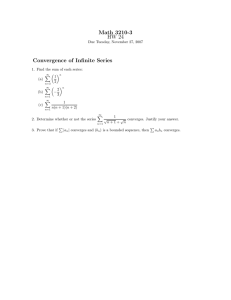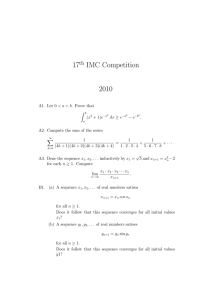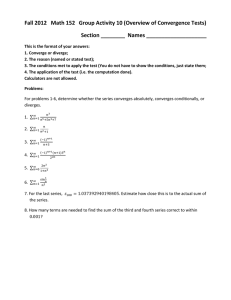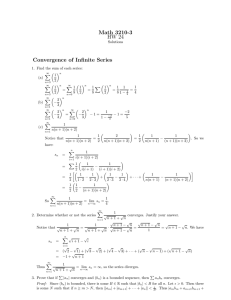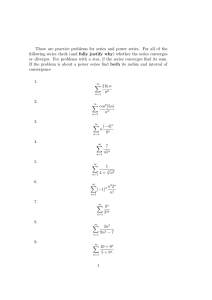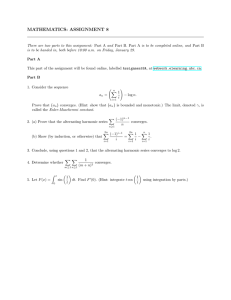Homework 5 Solutions
advertisement
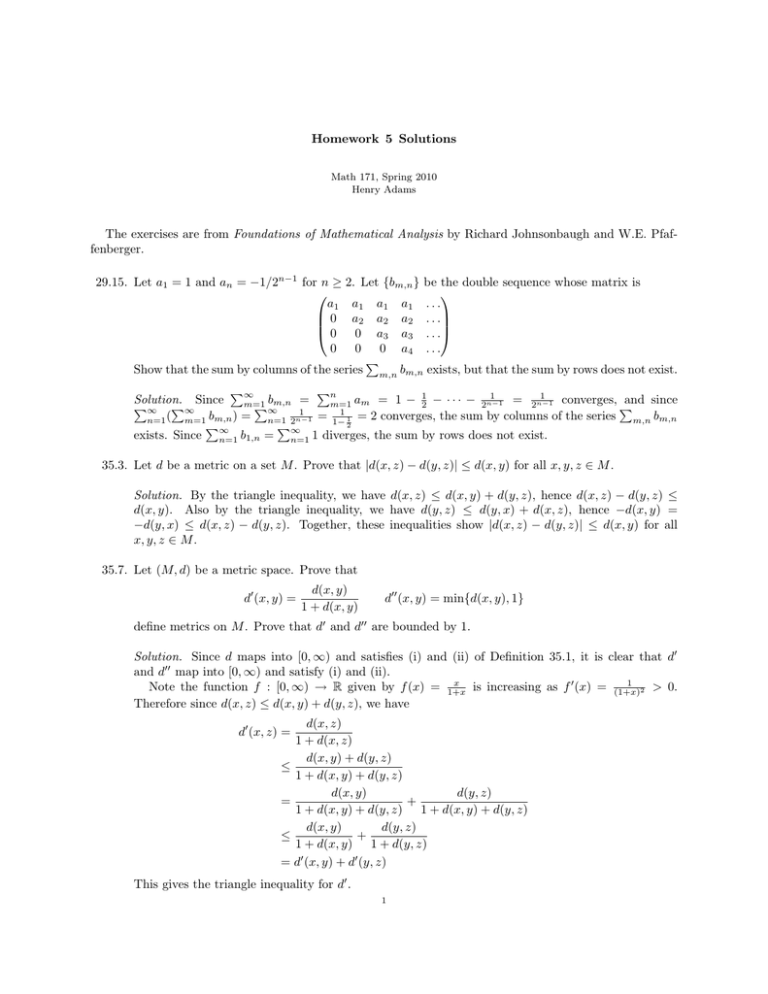
Homework 5 Solutions
Math 171, Spring 2010
Henry Adams
The exercises are from Foundations of Mathematical Analysis by Richard Johnsonbaugh and W.E. Pfaffenberger.
29.15. Let a1 = 1 and an = −1/2n−1 for n ≥ 2. Let {bm,n } be the double sequence whose matrix is
a1 a1 a1 a1 . . .
0 a2 a2 a2 . . .
0 0 a3 a3 . . .
0 0 0 a4 . . .
P
Show that the sum by columns of the series m,n bm,n exists, but that the sum by rows does not exist.
P∞
Pn
1
1
1
and since
Solution. Since
b
=
m=1
m=1 am = 1 − 2 − · · · − 2n−1 = 2n−1 converges, P
P∞ P∞
P∞m,n 1
1
(
=
2
converges,
the
sum
by
columns
of
the
series
b
)
=
=
n=1
m=1 m,n
m,n bm,n
n=1 2n−1
1− 21
P∞
P∞
exists. Since n=1 b1,n = n=1 1 diverges, the sum by rows does not exist.
35.3. Let d be a metric on a set M . Prove that |d(x, z) − d(y, z)| ≤ d(x, y) for all x, y, z ∈ M .
Solution. By the triangle inequality, we have d(x, z) ≤ d(x, y) + d(y, z), hence d(x, z) − d(y, z) ≤
d(x, y). Also by the triangle inequality, we have d(y, z) ≤ d(y, x) + d(x, z), hence −d(x, y) =
−d(y, x) ≤ d(x, z) − d(y, z). Together, these inequalities show |d(x, z) − d(y, z)| ≤ d(x, y) for all
x, y, z ∈ M .
35.7. Let (M, d) be a metric space. Prove that
d0 (x, y) =
d(x, y)
1 + d(x, y)
d00 (x, y) = min{d(x, y), 1}
define metrics on M . Prove that d0 and d00 are bounded by 1.
Solution. Since d maps into [0, ∞) and satisfies (i) and (ii) of Definition 35.1, it is clear that d0
and d00 map into [0, ∞) and satisfy (i) and (ii).
1
x
is increasing as f 0 (x) = (1+x)
Note the function f : [0, ∞) → R given by f (x) = 1+x
2 > 0.
Therefore since d(x, z) ≤ d(x, y) + d(y, z), we have
d(x, z)
1 + d(x, z)
d(x, y) + d(y, z)
≤
1 + d(x, y) + d(y, z)
d(x, y)
d(y, z)
=
+
1 + d(x, y) + d(y, z) 1 + d(x, y) + d(y, z)
d(x, y)
d(y, z)
≤
+
1 + d(x, y) 1 + d(y, z)
= d0 (x, y) + d0 (y, z)
d0 (x, z) =
This gives the triangle inequality for d0 .
1
Note
00
d (x, z) = min{d(x, z), 1} ≤ min{d(x, y) + d(y, z), 1} ≤ min{d(x, y), 1} + min{d(y, z), 1} = d00 (x, y) + d00 (y, z)
This gives the triangle inequality for d0 .
Hence d0 and d00 define metrics on M . It is clear that d0 and d00 are bounded by 1.
35.8. Let (M1 , d1 ) and (M2 , d2 ) be metric spaces. Prove that (M1 × M2 , d) is a metric space, where d is
defined by the formula
d[(x1 , x1 ), (y1 , y2 )] = d1 (x1 , y1 ) + d2 (x2 , y2 )
The space (M1 × M2 , d) is called the product metric space.
Solution. Since d1 and d2 map into [0, ∞) and satisfy (i) and (ii) of Definition 35.1, it is clear
that d maps into [0, ∞) and satisfies (i) and (ii). To see the triangle inequality, note
d[(x1 , x2 ), (z1 , z2 )] = d1 (x1 , z1 ) + d2 (x2 , z2 )
≤ d1 (x1 , y1 ) + d1 (y1 , z1 ) + d2 (x2 , y2 ) + d2 (y2 , z2 )
= d1 (x1 , y1 ) + d2 (x2 , y2 ) + d1 (y1 , z1 ) + d2 (y2 , z2 )
= d[(x1 , x2 ), (y1 , y2 )] + d[(y1 , y2 ), (z1 , z2 )]
Hence (M1 × M2 , d) is a metric space.
35.9. Let H ∞ denote the set of all real sequences {an } such that |an | ≤ 1 for every positive integer n. H ∞
is called the Hilbert cube.
P∞
n|
converges.
(a) Let {an }, {bn } ∈ H ∞ . Prove that the series n=1 |an2−b
n
n|
≤ 22n and
Solution. Since |an2−b
n
Theorem 26.3 (Comparison Test).
(b) Prove that d({an }, {bn }) =
P∞
P∞
n=1
2
n=1 2n
converges, we know that
|an −bn |
2n
defines a metric on H ∞ .
P∞
n=1
|an −bn |
2n
converges by
Solution. It is clear that d maps into [0, ∞) and satisfies (i) and (ii) of Definition 35.1. To see
the triangle inequality, note
∞
X
|an − cn |
d({an }, {cn }) =
2n
n=1
≤
∞
X
|an − bn | + |bn − cn |
2n
n=1
=
∞
∞
X
|an − bn | X |bn − cn |
+
2n
2n
n=1
n=1
= d({an }, {bn }) + d({bn }, {cn })
Hence d defines a metric on H ∞ .
36.4. Prove that if
P∞
n=1
a2n converges, then
P∞
n=1
an /n converges absolutely.
P∞
P∞
Solution. SinceP n=1 a2n converges, {an } ∈ l2 . Since n=1 (1/n)2 converges, {1/n} ∈ l2 . Hence by
∞
Theorem 36.3, n=1 an /n converges absolutely.
36.8. Let {an } ∈ l1 and {bn } ∈ l∞ . Prove that {an bn } ∈ l1 .
P∞
Solution. This is just a restatement of Theorem 26.4(i). Since {an } ∈ l1 , we know
n=1 an converges
P
∞
absolutely. Since {bn } ∈ l∞ , we know {bn } is bounded. By Theorem 26.4(i), n=1 an bn converges
2
absolutely, and hence {an bn } ∈ l1 .
36.11. Let {an } be a sequence such that {an bn } ∈ l1 for every sequence {bn } ∈ l1 . Prove that {an } ∈ l∞ .
Show (by example) that the above statement is false if l∞ is replaced by c0 .
Solution. Suppose for a contradiction that {an } ∈
/ l∞ , that is, {an } is not bounded. So for all
positive integers k and N there exists some n ≥ N such that |an | > k. Let N1 be such that aN1 > 1.
Let N2 > N1 be such that aN2 > 2. Continuing as such, let Nk > Nk−1 be such that aNk > k.
Define the sequence {bn } by
(
1
if n = Nk
2
bn = k
0
otherwise
P∞
P∞ 1
Note that n=1 |bn | = k=1 k2 converges, so {bn } ∈ l1 . However, note that
(
|an |
1
if n = Nk
2 ≥ k
|an bn | = k
0
otherwise
P∞
P∞
Since the series k=1 k12 diverges, this shows that n=1 |an bn | diverges by Theorem 26.3 (Comparison Test), and so {an bn } ∈
/ l1 . This is a contradiction, and so it must be the case that {an } ∈ l∞ .
To see that the statement is false if l∞ is replaced by c0 , let an = 1 for all n. Then {an } is a
sequence such that {an bn } ∈ l1 for every sequence {bn } ∈ l1 , but {an } ∈
/ c0 as the terms do not
converge to 0.
37.4. Show (by examples) that Theorem 37.2 does not generalize to l2 , c0 , or l∞ .
(
1 if n = k
(k)
(k) ∞
Solution. Let {δ }k=1 be defined by δn =
. Let an = 0 for every positive inte0 if n 6= k
(k)
ger n and let a = {an }. It is clear that limk→∞ δn = an for every positive integer n.
2
(k)
Note {δ (k) √
}∞
} does not converge to a in l2 since
k=1 is a sequence of points in l , but {δ
(k)
dl2 (δ , a) = 12 = 1 for every positive integer k.
∞
(k)
Note {δ (k) }∞
} does not converge to a in l∞ since
k=1 is a sequence of points in l , but {δ
dl∞ (δ (k) , a) = 1 for every positive integer k.
(k)
Note {δ (k) }∞
} does not converge to a in c0 since
k=1 is a sequence of points in c0 , but {δ
(k)
dc0 (δ , a) = 1 for every positive integer k.
Hence Theorem 37.2 does not generalize to l2 , c0 , or l∞ .
37.9. (a) Prove that the equation d0 (x, y) =
defines a metric on Rn .
Pn
i=1
|xi − yi | where x = (x1 , . . . , xn ), y = (y1 , . . . , yn ) ∈ Rn
Solution. It is clear that d maps into [0, ∞) and satisfies (i) and (ii) of Definition 35.1. To see
the triangle inequality, note that
0
d (x, z) =
n
X
i=1
0
|xi − zi | ≤
n
X
|xi − yi | + |yi − zi | =
i=1
n
X
i=1
|xi − yi | +
n
X
|yi − zi | = d0 (x, y) + d0 (y, z)
i=1
n
Hence d defines a metric on R .
(b) Let {a(k) } be a sequence of points in Rn , and let a ∈ Rn . Prove that {a(k) } converges to a
in (Rn , d) if and only if {a(k) } converges to a in (Rn , d0 ), where d is the usual metric for Rn .
Solution. By Theorem 37.2, it suffices to show that {a(k) } converges to a in (Rn , d0 ) if and only
(k)
if limk→∞ aj = aj for j = 1, . . . , n. We mimic the proof of Theorem 37.2.
3
First suppose that {a(k) } converges to a in (Rn , d0 ). Let > 0. There exists a positive integer N
such that if k ≥ N , then d0 (a(k) , a) < . Let j be a positive integer such that 1 ≤ j ≤ n. If k ≥ N ,
then
n
X
(k)
(k)
|aj − aj | ≤
|ai − ai | = d0 (a(k) , a) < i=1
and thus
(k)
limk→∞ aj
= aj for j = 1, . . . , n.
(k)
Now suppose that limk→∞ aj
= aj for j = 1, . . . , n. Let > 0. For each j there exists a positive
(k)
integer Nj such that if k ≥ Nj , then |aj
d0 (a(k) , a) =
n
X
− aj | < /n. If k ≥ max{N1 , . . . , Nn }, then
(k)
|ai
i=1
− ai | <
n
X
/n = i=1
and thus {a(k) } converges to a in (Rn , d0 ).
37.10. Let (M, d) be a metric space, and let d0 and d00 be defined as in Exercise 35.7. Let {an } be a sequence
in M and let a ∈ M . Prove that the following statements are equivalent.
(a) {an } converges to a in (M, d).
(b) {an } converges to a in (M, d0 ).
(c) {an } converges to a in (M, d00 ).
Solution. Let “iff” mean “if and only if”.
To see (a) is equivalent to (b), note that {an } converges to a in (M, d) iff limn→∞ d(an , a) = 0,
d(an ,a)
= 0, iff {an } converges to a in (M, d0 ).
iff limn→∞ d0 (an , a) = limn→∞ 1+d(a
n ,a)
To see (a) is equivalent to (c), note that {an } converges to a in (M, d) iff limn→∞ d(an , a) = 0, iff
limn→∞ d00 (an , a) = limn→∞ min{d(an , a), 1} = 0, iff {an } converges to a in (M, d00 ).
4
